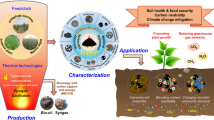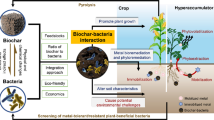Abstract
A greenhouse experiment was accomplished to investigate the feasibility of excess sludge modified by coal fly ash pretreatment and γ-ray irradiation in soil application for cultivation of Artemisia ordosica. The results showed that modified excess sludge provided a positive effect on the growth of Artemisia ordosica. The modified excess sludge and aeolian sandy soil at the volume ratio of 1:2 was optimal, and nutrient concentrations of Artemisia ordosica reached the highest. In the aeolian sandy soil, the bio-concentration factor values of most heavy metals were less than 1.0 except for Cu, Zn, and Ni. The average bio-concentration factor values of heavy metals in Artemisia ordosica increased in a sequence of Mo < Cd < Fe < V < Cr < Co < Mn < Pb < Cu < Zn < Ni for all samples. Artemisia ordosica could be used to decrease the bioavailability and eco-toxicity of Ni, V, and Mo in all cultivation experiments of artificial soil, and Artemisia ordosica could also reduce the bioavailability and eco-toxicity of Cu, Cd, Cr, and Mn in the artificial soil of modified excess sludge and aeolian sandy soil at the volume ratio of 1:2.




Similar content being viewed by others
References
Bremner J.M., Nitrogen-total, in: Sparks D.L., Page A.L., Helmke P.A., Loeppert R.H., Soltanpour P.N., Tabatabai M.A., Johnston C.T., Sumner M.E. (Eds.). (1996). Methods of soil analysis. Part 3-Chemical Methods, Soil Science Society of America, Madison, pp: 1085–1121.
Chao, H., & Zhihui, C. (2014). Effects of sludge on growth and physiology of green plant. Pratacultural Science, 31(4), 641–649.
Dolgen, D., Necdet, A. M., & Delen, N. (2007). Agricultural recycling of treatment plant sludge: a case study for a vegetable-processing factory. Journal of Environmental Management, 84, 274–281.
Hongtao, L. (2015). Heavy metal migration of seepage and runoff triggered by amendment of sludge compost as sod substrate. Environmental Science and Management, 40(10), 92–96.
Hu, Y., Pengfei, Z., Jianping, L., & Dezhen, C. (2015). Stabilization and separation of heavy metals in incineration fly ash during the hydrothermal treatment process. Journal of Hazardous Materials, 299, 149–157.
Libing, C., Wang, J., & Wang, B. (2011). Effect of gamma irradiation on activities and physicochemical characteristics of sewage sludge. Biochemical Engineering Journal, 54, 34–39.
Lima, D. Q., Oliveira, L. C. A., Bastos, A. R. R., Carvalho, G. S., Marques, J. G. S. M., Carvalho, J. G., & de Souza, G. A. (2010). Leather industry solid waste as nitrogen source for growth of common bean plants. Applied and Environmental Soil Science, 2010, 1–7.
Lu, R. (1999). Soil and agriculture chemistry analysis. Beijing: Agricultural Science and Technology Publisher of China.
Madhava Rao, K. V., & Sresty, T. V. S. (2000). Antioxidative parameters in the seedlings of pigeonpea (Cajanus cajan (L). Millspaugh) in response to Zn and Ni stresses. Plant Science, 157, 113–128.
Malavolta, E., Vitti, G. C., & Oliveira, S. A. (1997). Assessment of nutritional status of plants: principles and applications (2nd ed.). Potafos: Piracicaba.
Meulepas, R. J. W., Gonzalez-Gil, G., Teshager, F. M., Witharana, A., Saikaly, P. E., & Lens, P. N. L. (2015). Anaerobic bioleaching of metals from waste activated sludge. Science of the Total Environment, 514, 60–67.
Mucsi, G., Kumar, S., Csőke, B., Kumar, R., Molnár, Z., Rácz, Á., Mádai, F., & Debreczeni, Á. (2015). Control of geopolymer properties by grinding of land filled fly ash. International Journal of Mineral Processing, 143, 50–58.
Narwal, R. P., & Singh, B. R. (1998). Effects of organic materials on portioning extractability and plant uptake of metals in alum shale soil. Water, Air, and Soil Pollution, 103, 405–421.
Niu, D.-j., Hui, H., Xiao-hu, D., & You-cai, Z. (2013). Greenhouse gases emissions accounting for typical sewage sludge digestion with energy utilization and residue land application in China. Waste Management, 33, 123–128.
Nogueira, F. G., Castro, I. A., Bastos, A. R., Souza, G. A., de Carvalho, J. G., & Oliveira, L. C. (2011). Recycling of solid waste rich in organic nitrogen from leather industry: mineral nutrition of rice plants. Journal of Hazardous Materials, 186, 1064–1069.
Planquart, P., Bonin, G., Prone, A., & Massiani, C. (1999). Distribution movement and plant availability of trace metals in soils amended with sewage sludge composts: application to low metal loadings. The Science of the Total Environment, 241, 161–179.
Rovira, J., Mari, M., Nadal, M., Schuhmacher, M., & Domingo, J. L. (2011). Use of sewage sludge as secondary fuel in a cement plant: human health risks. Environment International, 37, 105–111.
Stylianou, M. A., Kollia, D., & Haralambous, K. J. (2007). Effect of acid treatment on the removal of heavy metals from sewage sludge. Desalination, 215, 73–81.
Wang, R., Jianzhong, L., Hu, Y., Junhu, Z., & Kefa, C. (2014). Ultrasonic sludge disintegration for improving the co-slurrying properties of municipal waste sludge and coal. Fuel Processing Technology, 125, 94–105.
Wong, J. W. C., & Su, D. C. (1997). Reutilization of coal fly ash and sewage sludge as an artificial soil-mix: effects of preincubation on soil physico-chemical properties. Bioresource Technology, 59, 97–102.
Wu, C., Guangming, Z., Panyue, Z., & Chein-Chi, C. (2014). Disintegration of excess activated sludge with potassium permanganate: feasibility, mechanisms and parameter optimization. Chemical Engineering Journal, 240, 420–425.
Xu J.-Q., Yu R.-L., Dong X.-Y., Hu G.-R., Shang X.-S., Wang Q., Li H.-W. (2012). Effects of municipal sewage sludge stabilized by fly ash on the growth of Manilagrass and transfer of heavy metals. Journal of Hazardous Materials, 217–218, 58–66.
Yu, R. L., Hu, G. R., & Wang, L. J. (2010). Speciation and ecological risk of heavy metals in intertidal sediments of Quanzhou Bay, China. Environmental Monitoring and Assessment, 163, 241–252.
Zheng, Y. R., Jiang, L. H., Yong, G., Xi, C., Luo, G. P., Feng, X. W., Y.J., Y., Ping, A., Yu, Y., & Hideyuki, S. (2013). Persistence of four dominant psammophyte species in central Inner Mongolia of China under continual drought. Journal of Arid Land, 5(3), 331–339.
Acknowledgments
The authors are grateful for the funding and support provided by the following projects: National Natural Science Foundation of China (21203163); the National Natural Science Gold Project; Shaanxi Provincial Science and Technology Department Foster Industrialization Projects (15JF035); and the Scientific Research Starting Foundation for high-level professionals in Yulin University of China (No. 12GK04).
Author information
Authors and Affiliations
Corresponding author
Rights and permissions
About this article
Cite this article
Xiang, Y., Xiang, Y., Wang, L. et al. Effects of Modified Excess Sludge on the Growth of Artemisia ordosica and Transformation of Heavy Metals. Water Air Soil Pollut 227, 123 (2016). https://doi.org/10.1007/s11270-016-2818-y
Received:
Accepted:
Published:
DOI: https://doi.org/10.1007/s11270-016-2818-y




